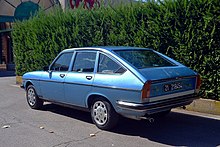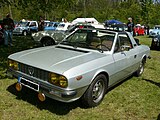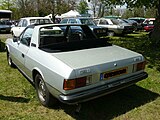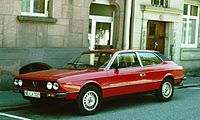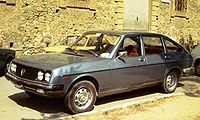Lancia Beta
| Lancia | |
|---|---|
|
Lancia Beta Berlina (2nd series 1975-1979)
|
|
| beta | |
| Production period: | 1972-1984 |
| Class : | Middle class |
| Body versions : | Sedan , coupé , station wagon coupé , convertible |
| Engines: |
Otto engines : 1.3-2.0 liters (60-99 kW) |
| Length: | 3813-4355 mm |
| Width: | 1646-1702 mm |
| Height: | 1190-1400 mm |
| Wheelbase : | 2300-2540 mm |
| Empty weight : | 970-1195 kg |
| Previous model | Lancia Fulvia |
| successor | Lancia Thema |
The Lancia Beta was a passenger car that was built by the Italian car manufacturer Lancia from autumn 1972 to the end of 1984 . It was named after the second letter of the Greek alphabet as a continuation of the nomenclature used at the beginning of the company's history . The standard model was a four-door hatchback sedan ( Berlina ), the exterior of which was redesigned by Pininfarina over the years . Other body variants with independently designed bodies were added later: the Beta Coupé was a two-door notchback, the Beta HPE a three-door station wagon , the Beta Spider a convertible with a targa roof and fixed roll bar and the Beta Trevi a four-door notchback sedan. Finally, under the name Beta Montecarlo , a two-seater mid - engine coupé was sold, which technically had little in common with the Beta family.
Limousine (Berlina)
The hatchback sedan, also known as the Berlina, appeared as the first model in the series in November 1972. The sedan's platform served as the basis for the following versions, Coupé, Spider, HPE and Trevi.
The hatchback body of the sedan, designed by Gian Paolo Boano in a modern way, met with little approval from some brand friends. It didn't have a large tailgate, but a small lid over the trunk. The passengers were not affected by the weather when opening the trunk, but access to the trunk was made difficult by the relatively small flap. The technology was modern. The Beta sedan offered front-wheel drive with transversely installed engines, five-speed gearbox, independent wheel suspension with struts all around and a special two-circuit brake system with four- and two-wheel division, in which braking power is always retained on both front wheels if one of the brake circuits fails ("Lancia Superduplex"), with discs on the front and rear axles. The independent suspension on all four wheels consisted of wishbones with a stabilizer and MacPherson struts at the front and the Camuffo rear axle with struts, two wishbones and a stabilizer at the rear . However, some lacked the originality typical of Lancia, and the Beta had a reputation for being a masked Fiat; in fact, the engines of the Lancia Beta were redesigned Fiat twin-cam engines with two overhead camshafts. Contemporary German test reports described the Lancia Beta as solidly built, economical, lavishly equipped and still a bit aristocratic.
Right from the start of production, the Lancia Beta had far-reaching safety features such as fully foamed interior panels, Lancia Superduplex braking system, three-part safety steering column, integrated roll bar, laminated glass windscreen (with the Coupé also the rear window), side impact protection, fire protection system and from 1979 catch hooks for the bonnet .
For all moldings, bezels and bumpers Lancia used stainless steel for the Beta (except for the Montecarlo).
The advantages of the Beta included space, comfort, high-torque engines, safe road holding and powerful brakes. Initially, there were three inline four-cylinder engines in the range, a 90 hp (66 kW) 1.4-liter engine, a 100 hp (74 kW) 1.6-liter engine and a 1.75-liter engine with 110 hp (81 kW). The official designations of the vehicles with these engine variants were 1400, 1600 and 1800. Thanks to the well-graded 5-speed gearbox, the Lancia Beta offered an elasticity that was only achieved by a few competitors in this performance class.
Two equipment variants were available: a basic model and the Beta LX, although this was not offered in conjunction with the 1.4-liter engine.
Coupe
In June 1973 the Beta Coupé made its debut on the sedan's shortened base plate. The first series vehicles were delivered in spring 1974.
The design came from Castagnero, who had already designed the Lancia Fulvia Coupé of the sixties. The 1600 and 1800 versions of the Coupé were initially powered by 1.6 and 1.75 liter double camshaft engines with 109 and 120 hp, respectively. The equipment was upgraded compared to the sedan.
After production of the Fulvia Coupé was discontinued in January 1976, the Beta Coupé was also equipped with the 1.3-liter engine so that it could continue to offer a coupé in the 1300 class, which is particularly important in Italy.
Spider
In autumn 1974 the Beta Spider appeared, which was based on the shorter platform of the Coupé.
The Beta Spider is equipped with a removable plastic roof between the windscreen frame and the Targa bar and a rear, foldable fabric hood.
The open 2 + 2-seater was manufactured at Carrozzeria Zagato , where the body shell of the Beta Coupé was converted. Initially, the body was converted to frameless side windows and there were no stiffening elements between the windshield frame and the roll bar. Since the vehicles built in this way turned out to be extremely resistant to torsion, later specimens were made with bars between the A and B pillars and the normal doors with window frames were installed. Still, torsional stiffness wasn't the Spider's strong point.
In the Beta Spider, the more powerful engine versions from the Coupé were installed, initially as the 1600 and 1800 versions. After the revision and conversion of the engine range for all versions of the Beta in autumn 1975, the Spider was equipped with the new version of the 1600 engine and the two-liter -Motor (type 828.BS.1) produced, which replaced the 1800s. Smaller engines were not available in the Spider.
Zagato also adopted the basic concept of the Spider for the Bristol 412 designed in Milan and introduced in 1974 , which also used the Lancia's taillights.
HPE
In the spring of 1975, a three-door appeared as the fourth body variant Combi Coupé called HPE (for H igh P erformance E state). With the unchanged floor pan of the sedan, the HPE is identical to the Beta Coupé up to the B-pillar.
The Beta HPE was based on a Pininfarina design. Lancia took over a body concept that had been developed by Tom Karen and Ogle Design for the British Reliant Scimitar back in 1967 .
The vehicle was built with a 1.6-, 1.8- and 2.0-liter engine, the latter being offered as a carburetor, injector and the Volumex compressor variant . The passenger compartment was spacious, comfortable (also in the rear) and suitable for long journeys, as the HPE had good road holding and above-average performance.
The dashboard contains nine analog instruments (large speedometer and rev counter, smaller fuel gauge, cooling water thermometer, voltmeter, oil manometer, thermometer and level indicator, as well as a clock in the center console). Even the oil level is displayed via a vacuum line on the dashboard. Another special feature was the automatic headlight height adjustment with pressure pistons, which are controlled by pneumatic sensors on the rear axle via a pressure hose.
Montecarlo
In September 1975, the two-seater mid - engine coupe Beta Montecarlo with a body designed by Pininfarina came on the market, which was also produced as a Targa with a roll-top roof. The origins of the Montecarlo go back to the prototype Abarth 030 Pininfarina, the Fiat X1 / 9 and later the Fiat X 1/20.
The Montecarlo was only available with the 88 kW (120 hp) twin-camshaft two-liter Lampredi engine . It was the first automobile whose body structure, including the exterior design, was developed by Pininfarina and manufactured on the company's own production lines for Lancia.
For the American market there was a special variant with modified (round) folding headlights and only 65 kW (88 PS) under the name Scorpion because the emission values were not sufficiently met there. Even the supporting role in the movie The Great Beetle in the Monte Carlo Rally from 1977 alongside the famous VW Beetle Herbie could not bring the only 3.81 m short Lancia to sales in the USA.
In May 1978 production of the Beta Montecarlo was initially terminated.
At the beginning of the eighties, the Fiat group needed a new vehicle for use in rally sport, as the usability of the Fiat 131 in this sport had come to an end. Since the emerging regulations of Group B required the derivation of the competition vehicle from a series model from current production and there was only one model in the group from which a rally vehicle could reasonably be derived, production of the Montecarlo was resumed.
In March 1980 a revised version (S2) of the Montecarlo (also 88 kW) appeared in Europe, which was the first to be closed by the modified radiator grille - which was designed analogously to the Beta series modified in autumn 1979 - and additional windows in the C-pillars is different. These windows had already been introduced in Great Britain in the first series in order to meet the local approval requirements for all-round visibility. The model was now only called Lancia Montecarlo, the name Beta was dropped. Series 2 also received the wheel design of the other Beta models with 14 "instead of 13" rims (albeit with increased offset and oval recesses for the wheel bolts, instead of the round recesses that are otherwise common in the Beta). The braking system was revised and the brake discs enlarged.
The vehicles of the first series had a very unusual brake system with a vacuum servo on the right behind the passenger seat, which was integrated via very complex and long hydraulic lines and only supplied the front brakes. This resulted in frequent overbraking of the front axle on wet or slippery roads, which was very unfavorable for driving safety. In addition, the servo was prone to severe corrosion due to its installation position, in many vehicles it then got stuck and the brakes blocked completely. This is why this brake servo was often shut down or expanded even during the series 1 era. This is why this brake booster was not used in the second series. Instead, there was a mechanical amplifier that worked with leverage on both brake circuits.
Important models for motorsport and especially rallying were derived from the Lancia Beta Montecarlo . These were the Lancia Turbo, which according to the FIA Group 5 rules only had the silhouette of the production vehicle, and won the Manufacturers' World Championship for Lancia in 1980 and 1981 . The Lancia Rally 037 was derived for rally use . However, the 037 shared only a few details with the series vehicle and had, among other things, a tubular space frame in the front and rear that was attached to the series passenger cell of the Montecarlo.
In June 1981, production finally came to an end after almost 7600 units. This could not prevent Hans Heyer's win of the German racing championship in 1980 with the Montecarlo.
Trevi
The Beta Trevi notchback variant made its debut in March 1980, targeting conservative customers who were often distant from Lancia's hatchbacks. The body of the Beta Trevi was designed by in-house designers; Pininfarina contributed detailed work. The Beta Trevi was identical to the Berlina up to the rear doors; in the rear there was a steep C-pillar and a backpack-like trunk. The design of the rear area was often perceived as inharmonious or bland. This contrasted with the futuristic dashboard designed by the Milanese architect and industrial designer Mario Bellini . It was a curved unit made of colored plastic, curved towards the driver. There were about 30 round recesses in which switches and individual displays were located. Bellini's design was often derided as "Swiss cheese". The engine range of the Trevi largely corresponded to that of the Beta Berlina. As an entry-level model in the Trevi, Lancia offered a 1.6-liter version with 74 kW (101 hp) in many markets (but not in Germany); Above it was a variant with a displacement of 2.0 liters and 85 kW (116 PS). Both engines were equipped with double Weber carburetors. From 1981, however, the larger engine was available as an alternative - or exclusively on the German market as a naturally aspirated engine - with Bosch electronic intake manifold injection (L-Jetronic), with an output of 90 kW (122 hp). For the 1982 model year, the new top model was the Trevi 2000 Volumex, which was equipped with a Roots compressor . The Trevi Volumex was the first mass-produced car with mechanical turbocharging since the end of World War II . The Volumex engine was not available with manifold injection, but only with conventional carburetors. In the spring of 1983 the sedan was slightly modified. The model name Beta was dropped; the car was now called "Lancia Trevi". From 1980 to 1984 Lancia, all engines combined, produced 40,628 copies of the Trevi, of which 3,844 were Volumex.
Facelift
1975
In September 1975 the beta was visually and technically revised. The sedan was redesigned by Pininfarina in a number of details, which concerned the radiator grille, headlights, rear lights, rubber strips on the flanks and a new plastic trim insert on the third side window. In the entry-level engine 1300, the Berlina continued to use the black plastic grill.
The engine range was now divided into 1.3-liter (82 hp), 1.6-liter (100 hp) and two-liter (119 hp).
On the Camuffo rear axle, the ball joints for connecting the stabilizer tension strut and steering knuckle have been replaced by rubber silent bushings. The mounting of the stabilizer tension strut on the vehicle body has also been changed.
The Coupé, Spider and HPE also received slight changes to the front end: the bonnet was changed, the radiator grille was now black and had chrome strips. At the beginning of 1976, the 1.3-liter engine was added for the Beta Coupé, which got the 82 hp unit from the sedan, but was more simply equipped.
1978/1979
After the Coupé, HPE and Spider were slightly revised for the IAA in September 1978 (modified radiator grille and exterior mirrors made of black plastic), the sedan underwent a comprehensive overhaul in autumn 1979.
The front was retouched and the interior refreshed with a dashboard with numerous round openings in which instruments and warning lights were located. The range of engines shrank to 1.6 l (100 hp) and 2.0 l petrol (115 hp).
1981
In June 1981 the Coupé, Spider and HPE underwent another refresh. This concerned the radiator grille, a new dashboard, new upholstery materials, black painted chrome parts made of stainless steel as well as larger and wider bumpers for the versions 1600 and 2000. The Coupé in version 1300 kept the original bumpers until the end of production, but in black . The coupe was equipped with a black spoiler on the tailgate. From this point on, the HPE was called HPExecutive (High Performance Executive) in most markets.
The two-liter engines of the Beta series (up to the Berlina and Montecarlo) received electronically controlled Bosch L-Jetronic injection in autumn 1981, which increased their output to 122 hp. The Spider was a special case. It was only offered with the injection system in North America, with a carburettor in the remaining markets until the end of production. The coupé's 1.3 liter engine grew to 1367 cm³ and developed 84 hp.
At the same time as the revision, the hatchback sedan dropped out of the German range. In Italy you could order them until the end of the year.
From April 1982 the Beta Spider was no longer listed in Lancia's official German sales program. The Volumex variant , which was offered in the Trevi, Coupé and HPE models, was new . These were powered by a two-liter four-cylinder with a volumetric compressor that made 135 hp. This brought the HPE and Coupé to a top of 200 km / h and needed nine seconds for the sprint from 0 to 100 km / h.
When the Spider was discontinued, the term beta was no longer available on the German market. The vehicles were only called Trevi, Coupé and HPExecutive.
In December 1984 the production of all beta and Trevi models was stopped.
Engines
| Model name | Construction period | engine | Displacement (cm³) | Horsepower) | Top speed (km / h) | Fuel system | Body variant |
|---|---|---|---|---|---|---|---|
| 1300 | 1974-1984 | Inline - four-cylinder | 1297 cm³ (1978–1981: 1301 cm³, from 1981: 1367 cm³) |
82 PS (from 1981: 84 PS) | 160 km / h (Coupé: 168 km / h) | Register carburetor | Berlina, coupe |
| 1400 | 1972-1975 | Inline - four-cylinder | 1438 cc | 90 hp | 165 km / h | Register carburetor | Berlina |
| 1600 | 1972-1975 | Inline - four-cylinder | 1592 cm³ | 100 PS (Coupé: 108 PS) | 170 km / h (Coupé: 180 km / h; HPE: 178 km / h) | Register carburetor | Berlina, Coupé, Spider, HPE |
| 1600 | 1975-1984 | Inline - four-cylinder | 1585 cc | 100 hp | 170 km / h (Coupé: 180 km / h; HPE: 178 km / h) | Register carburetor | Berlina, Coupé, Spider, HPE, Trevi |
| 1800 | 1972–1975 (USA: until 1978) | Inline - four-cylinder | 1756 cc | 110 PS (Coupé: 120 PS) | 175 km / h (Coupé: 190 km / h; HPE: 180 km / h) | Register carburetor | Berlina, Coupé, Spider, HPE |
| 2000 | 1975-1981 | Inline - four-cylinder | 1995 cc | 119 hp (from 1979: 115 hp, except Montecarlo) | 180 km / h (Coupé / Montecarlo: 188 km / h; HPE: 185 km / h) | Register carburetor | Berlina, Coupé, Spider, HPE, Montecarlo |
| 2000 i. e. | 1981-1984 | Inline - four-cylinder | 1995 cc | 122 hp | 183 km / h (Coupé: 190 km / h; HPE: 188 km / h) | electr. Manifold injection | Trevi, Coupé, HPE, Spider |
| 2000 VX | 1982-1984 | Inline - four-cylinder | 1995 cc | 135 hp | 190 km / h (Coupé / HPE: 200 km / h) | Double carburetor with compressor | Trevi, Coupé, HPE |
Body versions and dimensions
| Type | Body version | Doors | Length [mm] | Width (mm] | Height [mm] | Wheelbase [mm] |
|---|---|---|---|---|---|---|
| Berlina | Hatchback sedan | 4th | 4293-4320 | 1651 | 1397 | 2540 |
| Coupe | Coupe | 2 | 3933 | 1651 | 1280 | 2350 |
| Spider | Targa | 2 | 4040 | 1646 | 1250 | 2350 |
| HPE | Combi coupe | 3 | 4285 | 1651 | 1321 | 2540 |
| Montecarlo | Mid-engine - coupe and - Targa | 2 | 3813 | 1702 | 1190 | 2300 |
| Trevi | Notchback sedan | 4th | 4355 | 1700 | 1400 | 2540 |
Quantities
Of the different versions were built in Italy:
| Type | construction time | number of pieces |
|---|---|---|
| Berlina | November 1972 - December 1981 | 194.916 |
| Coupe | June 1973 - December 1984 | 113,623, of which 1272 are Volumex |
| Spider | November 1974 - August 1982 | 8594 |
| HPE | April 1975 - December 1984 | 71,257, of which 2,369 are Volumex |
| Montecarlo | September 1975 - June 1981 | 7595 |
| Trevi | March 1980 - December 1984 | 52,567, of which 3,884 are Volumex |
The variants Berlina (sedan), Coupé, HPE, Spider (as Lancia Zagato) and Montecarlo (the latter under the name Lancia Scorpion) were exported to the USA from autumn 1975 to mid-1982. 17,965 copies were sold in seven years.
The beta in Spain
The Lancia Beta Coupé and the Lancia Beta HPE were also manufactured by Seat under a Lancia license from 1979 to 1980.
The bodies corresponded to the Lancia Beta from Italy. The models were powered by an in-line four-cylinder engine with 1917 cm³ displacement, which developed 80 kW (109 hp). This engine was also used in the Seat 131 and Seat 132 . The Lancia models achieved 180 km / h.
These vehicles were the only cars manufactured by Seat that did not have a Seat emblem. The success was moderate with 2,746 copies.
Sport and racing versions
Lancia Beta Berlina
The Beta Berlina Group 1 according to FIA regulations was the first vehicle from the Beta series to be used in racing. In 1973 the famous Italian Jolly Club team started with a Beta Berlina for the first time. The Jolly Club Team took part in all Italian events of Group 1 of the series touring cars in 1973, as well as in the San Remo Rally and the Ivory Coast Rally (then called Rallye Bandama) of the same year. It was not used as a Lancia works vehicle .
Lancia Beta Coupe
The Lancia Beta Coupé was used by private drivers and also by Lancia itself as a Lancia rally works vehicle. The homologation included two different versions: A version according to group 3 with the 8-valve cylinder head of the series vehicle and another version with the Abarth 16-valve cylinder head, which corresponded to the regulations of group 4. The factory vehicles were first series vehicles with an 1800 engine and typical body features such as a flat bonnet with two ventilation grilles and a rounded roof edge. The vehicles were equipped with two double carburetors and, during the 1975 season, with limited slip differentials and power steering. The engine output was between about 175 PS (129 kW) as an 8V and 195 PS (143 kW) as a 16V. The later Lancia Delta Integrale was based on the chassis technology (front suspension with MacPherson struts , Camuffo rear axle ) and the drive concept with transverse front engine ( Fiat Twin-Cam engine ) on the Lancia Beta. With a 2-liter engine, supplemented by all-wheel drive and a turbocharger, this basic concept of the Beta led to numerous rally victories.
Lancia works vehicle
In 1974 and 1975 Lancia used the Beta Coupé as an official Lancia works vehicle in the World Rally Championship . The vehicles were used in a total of eleven races, including well-known events such as the Tour de Corse , the San Remo Rally , the RAC Rally , the Monte Carlo Rally , the Rally Sweden , the Rally Rideau Lakes and the Safari Rally . The Lancia Beta Coupé achieved several places in the top ten, including 3rd place in the 1975 Rally Sweden and several 4th places (San Remo Rally 1974 and 1975, Press-On-Regardless Rally 1974).
At the Rideau Lakes Rally in 1974, the vehicle's second official outing, shortly before the end of the race, the Lancia Beta Coupé was still in front of a Lancia Stratos that was taking part at the same time . Due to a stable order from team boss Cesare Fiorio , Simo Lampinen had Sandro Munari in his Stratos overtaken in his Beta Coupé shortly before the end of the race and only finished second.
In 1975 Lancia stopped using the Beta Coupé and concentrated on developing the Lancia Stratos .
Operations by private drivers
The Beta Coupé was used in competitions by several private drivers. The best- known team was the Reseau Chardonnet of the French Lancia importer André Chardonnet . It took over a former works vehicle from Lancia and used it in French races, with Bernard Darniche and Anne-Charlotte Verney as drivers, among others . In 1977 Bernard Darniche and Jean-Louis Clarr won the 24 Heures sur Glace de Chamonix race (24 hours on ice in Chamonix).
swell
- NN: The history of Lancia from 1906–1989. Factory brochure, Turin 1989.
literature
- Purchase advice Beta Montecarlo In: Oldtimer market . 3/2009, p. 42 ff.
- Matthias Gerst: Typenkompass Lancia: passenger cars after 1945. Motorbuch Verlag, Stuttgart 2007, ISBN 978-3-613-02593-6 , pp. 55-65.
- Paul Schinhofen: Lancia - innovation and fascination: 100 eventful years. Heel Verlag, Königswinter 2006, ISBN 3-89880-649-9 , pp. 82-89.
Web links
Individual evidence
- ↑ https://www.hs-coburg.de/fileadmin/SG_AT/Vortrag_Bremsen.pdf ( page no longer available , search in web archives ) Info: The link was automatically marked as defective. Please check the link according to the instructions and then remove this notice.
- ↑ http://www.lancia-beta.de/grund/grund-brems.htm#grund-re04
- ↑ aristocrat offside . In: The time . No. 04/1975 ( online ).
- ↑ Lancia - Progress from Tradition, Editoriale Domus, p. 170.
- ↑ LANCIA The program of the brand world champion - Lancia program Dr No. A1 100 Sept 81 MWW, Fiat Automobil AG Heilbronn, 1981.
- ↑ LANCIA MODELS, DATA, PRICES - as of April 5, 1982, LANCIA Fiat Automobil AG Heilbronn, 1982.
- ^ Mike Covello: Standard Catalog of Imported Cars 1946-2002. In: Krause Publications , Iola (USA) 2002, ISBN 0-87341-605-8 , p. 469 (English).
| Timeline of Lancia and Autobianchi models since 1945 | ||||||||||||||||||||||||||||||||||||||||||||||||||||||||||||||||||||||||||||
|---|---|---|---|---|---|---|---|---|---|---|---|---|---|---|---|---|---|---|---|---|---|---|---|---|---|---|---|---|---|---|---|---|---|---|---|---|---|---|---|---|---|---|---|---|---|---|---|---|---|---|---|---|---|---|---|---|---|---|---|---|---|---|---|---|---|---|---|---|---|---|---|---|---|---|---|---|
| Type | Lancia, independent until 1969 | Purchased by Fiat in 1969, Fiat number range since then | ||||||||||||||||||||||||||||||||||||||||||||||||||||||||||||||||||||||||||
| Autobianchi, JV between Bianchi, Fiat and Pirelli | from 1967 100% part of the Fiat group | abroad as Lancia, in Italy as Autobianchi | ||||||||||||||||||||||||||||||||||||||||||||||||||||||||||||||||||||||||||
| 1940s | 1950s | 1960s | 1970s | 1980s | 1990s | 2000s | 2010s | 2020s | ||||||||||||||||||||||||||||||||||||||||||||||||||||||||||||||||||||
| 5 | 6th | 7th | 8th | 9 | 0 | 1 | 2 | 3 | 4th | 5 | 6th | 7th | 8th | 9 | 0 | 1 | 2 | 3 | 4th | 5 | 6th | 7th | 8th | 9 | 0 | 1 | 2 | 3 | 4th | 5 | 6th | 7th | 8th | 9 | 0 | 1 | 2 | 3 | 4th | 5 | 6th | 7th | 8th | 9 | 0 | 1 | 2 | 3 | 4th | 5 | 6th | 7th | 8th | 9 | 0 | 1 | 2 | 3 | 4th | 5 | 6th | 7th | 8th | 9 | 0 | 1 | 2 | 3 | 4th | 5 | 6th | 7th | 8th | 9 | 0 | |
| Microcar | Bianchina | Giardiniera | ||||||||||||||||||||||||||||||||||||||||||||||||||||||||||||||||||||||||||
| Small car | A112 | Y10 (156) | Y (840) | Ypsilon (843) | Ypsilon (846) | |||||||||||||||||||||||||||||||||||||||||||||||||||||||||||||||||||||||
| Compact class | A111 | Delta I [2] (831) | Delta II (836) | Delta III (844) | ||||||||||||||||||||||||||||||||||||||||||||||||||||||||||||||||||||||||
| Middle class | Primula | Prism (831) | Dedra (835) | Lybra (839) | ||||||||||||||||||||||||||||||||||||||||||||||||||||||||||||||||||||||||
| ... Ardea | Appia | Fulvia | Beta / Trevi (828) | Flavia | ||||||||||||||||||||||||||||||||||||||||||||||||||||||||||||||||||||||||
| upper middle class | Flavia | 2000 | Gamma (830) | Theme (834 / Y9) | Kappa (838) | Thesis (841) | theme | |||||||||||||||||||||||||||||||||||||||||||||||||||||||||||||||||||||
| Coupé / convertible | Stellina | |||||||||||||||||||||||||||||||||||||||||||||||||||||||||||||||||||||||||||
| Fulvia Coupé / Sport | Beta Coupé [1] / Spider / Montecarlo (828) | |||||||||||||||||||||||||||||||||||||||||||||||||||||||||||||||||||||||||||
| Aurelia | Flaminia | Gamma Coupé / GT (830) |
Kappa Coupé (838) |
|||||||||||||||||||||||||||||||||||||||||||||||||||||||||||||||||||||||||
| Sports car | Stratos | |||||||||||||||||||||||||||||||||||||||||||||||||||||||||||||||||||||||||||
| Minivan | Musa (350) | |||||||||||||||||||||||||||||||||||||||||||||||||||||||||||||||||||||||||||
| Van | Zeta (220) | Phedra (179) | Voyager | |||||||||||||||||||||||||||||||||||||||||||||||||||||||||||||||||||||||||
|
[1] also built by Seat in Spain |
||||||||||||||||||||||||||||||||||||||||||||||||||||||||||||||||||||||||||||


